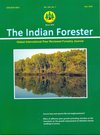Effect of Different Pressure Treatment Methods on Dimensional Stabilization of Chemically Modified Pinus radiata Wood
DOI:
https://doi.org/10.36808/if/2016/v142i7/98987Keywords:
Chemical Modification, Acetic Anhydride, Pressure Treatment, Weight per Cent Gain, Volumetric Swelling Coeffident, Anti-Swelling Effidency.Abstract
Wood is dimensionally unstable and hygroscopic in nature due to presence of large number of hydroxyl groups in the polymeric constituents. Chemical modification is one way of improving this property and acetylation provides dimensional stability to wood, due to cell wall bulking. In the present study Pinus radiata wood samples were modified with pyridine catalyzed acetic anhydride by combination of pressure and heat treatment for different time periods. Weight Percentage Gain, Volumetric Swelling Coefficient and Anti-Swelling Efficiency were determined. Samples were immersed in waterfora time period of 1hr to 120hrs to calculate Volumetric Swelling Coefficient and Anti-Swelling Efficiency for estimating dimensional stability. Schedule of applying pressure of 20lbs per inch2 at 120 °C for 1hr showed maximum dimensional stability.References
Ajdinaj D., Lato E., Quku D. and Cota H. (2013). Modification of some Albanian wood properties through chemical treatment. Int. J. Physical Sciences, 8(9y.3Se-3ei.
Donath S., Militz H. and Mai C. (2004). Wood modification with alcoxysilanes. Wood Science Technology, 38:555-566.
Hansmann C, Weichslberger G., and Gindl W. (2005). A two-step modification treatment of solid wood by bulk modification and surface treatment. Wood Science Technology, 39:502-511.
Hill C.A.S.(2006). Wood modification: chemical, thermal and other processes. John Wiley and sons ltd.
Hill C.A.S. (2007). Acetylated wood - the science behind the material, http://www.accoya.com/wp-content/uploads/2011/05/Acetylatedwood. pdf Accessed 23 April 2013.
Imamura Y. and NishimotoK. (1987). Some aspects on resistance of acetylated wood against bio deterioration. Wood Research, 74:33-44.
Matsuda H. (1987). Preparation and utilization of esterified woods bearing carboxyl groups. Wood Science Technology, 21:75-88.
Obataya E. and Yamauchi H. (2005). Compression behaviors of acetylated wood in organic liquids Part II drying set and its recovery. Wood Science Technology, 39:S4e-SS9.
Rowell R.M. (1982). Distribution of acetyl groups in southern pine reacted with acetic an hydride. Wood Science, 15 (2): 172-182.
Rowell R.M. (1983). Chemical modification of wood. Forest Product Abstracts, 6(12): 363-382.
Rowell R.M. (2005.a). Chemical modification: A nontoxic approach to wood preservation. Drewno-wood, 48 (173): 111-117.
Rowell R.M. (2005.b). Chemical modification of wood. Handbook of wood chemistry and wood composite. CRC Press. 381-420.
TarkowH. and StammA.J. (1955). Acetylated wood, forest product laboratory, USDA.
Downloads
Downloads
Published
How to Cite
Issue
Section
License
Unless otherwise stated, copyright or similar rights in all materials presented on the site, including graphical images, are owned by Indian Forester.





